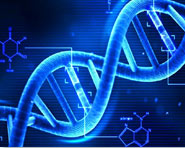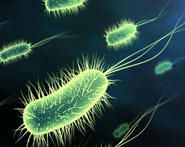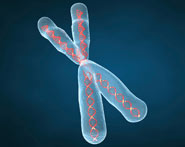


 النبات
النبات
 الحيوان
الحيوان
 الأحياء المجهرية
الأحياء المجهرية
 علم الأمراض
علم الأمراض
 التقانة الإحيائية
التقانة الإحيائية
 التقنية الحيوية المكروبية
التقنية الحيوية المكروبية
 التقنية الحياتية النانوية
التقنية الحياتية النانوية
 علم الأجنة
علم الأجنة
 الأحياء الجزيئي
الأحياء الجزيئي
 علم وظائف الأعضاء
علم وظائف الأعضاء
 الغدد
الغدد
 المضادات الحيوية
المضادات الحيوية|
Read More
Date: 9-3-2016
Date: 14-3-2016
Date: 9-3-2016
|
In medicine, biofilms can contaminate and colonize hip replacements, endotracheal tubes, medical catheters, stents, heart valves, or contact lenses. The film that develops on teeth to form plaque is also a biofilm. Medical researchers now explore the role of biofilms that colonize chronic wounds and prevent them from healing.
Biofilms are known to cause or worsen the following five medical conditions: (1) dental decay, (2) an acute ear infection called otitis media, (3) the respiratory diseases cystic fibrosis and Legionnaires’ disease, (4) urinary tract infections, and (5) bacterial endocarditis, an infection of the inner heart. In the latter condition, infection spreads from the heart to other parts of the body, when cells slough off the biofilm and enter the bloodstream.
Medical researchers have investigated ways to prevent biofilm from forming on medical devices to reduce the chance of contamination. Low-energy sound waves have been shown to block cells from attaching to device surfaces. Rodney M. Donlan of the Centers for Disease Control and Prevention (CDC) said, in 2007, “One important advantage of this approach is that the use of antimicrobial agents is not required.” Fitting medical devices with a component that continuously emits sound waves at a constant frequency will not be an easy task. But because ebiofilms display strong resistance to chemical biocides, few options have been available for killing biofilms.
Biofilms also affect water quality by creating bad tastes and odors. Biofilms form along the inner surfaces of pipes that distribute drinking water to houses and other buildings. They contribute a steady amount of bacteria and other microorganisms to the water flowing toward taps. Very active biofilms have been known to corrode distribution lines made of cast iron and other metals. This is one reason why many newer water distribution systems use plastic polyvinyl chloride (PVC) piping. Though biofilm still forms on the plastic, chemists originally believed the plastic did not corrode as easily as metal. Scientists now think biofilm may corrode PVC as it does metal. Since biofilms are highly resistant to chemical disinfectants, the chlorine in water often has little effect on them. To make matters worse, clusters break off periodically in a process called detachment. Bio film detachment causes bacterial numbers in drinking water to fluctuate. After detachment, biofilm rebuilds its lost portions in a process called regrowth.
On pipes, drains, or boats and ships, biofilm corrosion weakens metals over time, and, if left unchecked, the corrosion develops into something more serious than a mere nuisance. For example, in some industries biofilms ruin equipment or spoil products. Experts in oil drilling, paper milling, food processing, and oceangoing cargo shipping all must contend with the constant removal of biofilms from their equipment. Damage caused by biofilms costs these industries millions of dollars each year in lost product or in cleaning and repairing of equipment. They are of particular concern in food processing plants, because food ingredients provide a rich conditioning film inside the production line equipment. A single biofilm community in a food processing line will contaminate every batch of food product as it moves through the line.
In addition to sound waves, biofilm researchers study other ways to prevent biofilms from attaching to hard inanimate surfaces. Their first approach is to find materials that repel biofilm attachment. So far, few materials upon which biofilm does not attach have been discovered. The U.S. Navy has experimented with special coatings over the hulls of their ships that will potentially repel bacteria, but this has also been only partially successful. Other methods involve the application of an electric charge that causes the biofilm to detach.
In medical research, microbiologists seek com pounds that will inhibit the activities of pathogenic species in biofilms. One technique may be to disrupt the genes associated with quorum sensing. In 2007, the microbiologist Jeffrey L. Fox wrote in Microbe magazine, “The term ‘sociomicrobiology’ alludes to the highly ‘structured’ communities that can form within biofilms that can prove ‘important to their success as pathogens,’ says [Peter] Greenberg of the University of Washington.” Because persistent biofilm communities may depend on quorum sensing, this aspect of biofilm activity offers a promising way to disrupt biofilms. Harmful biofilms, nonetheless, remain very difficult problems in medicine and in other areas.



|
|
|
|
التوتر والسرطان.. علماء يحذرون من "صلة خطيرة"
|
|
|
|
|
|
|
مرآة السيارة: مدى دقة عكسها للصورة الصحيحة
|
|
|
|
|
|
|
نحو شراكة وطنية متكاملة.. الأمين العام للعتبة الحسينية يبحث مع وكيل وزارة الخارجية آفاق التعاون المؤسسي
|
|
|